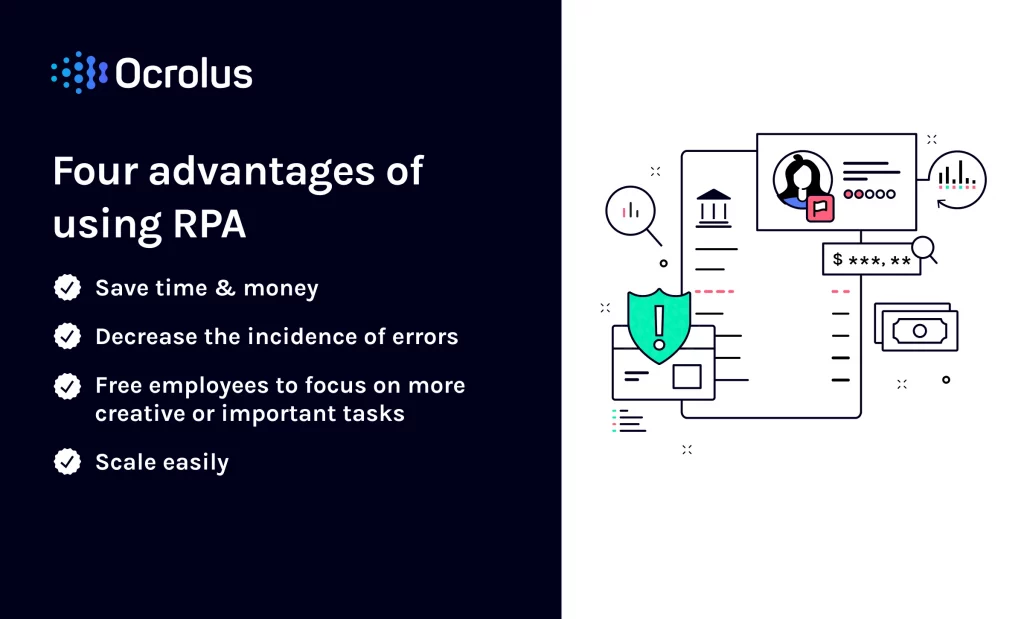What is RPA, and How Can it Help Fintech & Lenders

How many times have you called customer service and relayed the same information — name, order number — over and over again as agents play “pass the baton” with your transaction query? At a time when customer experience is everything, businesses can’t afford such friction in routine processes. Robotic process automation (RPA) has the potential to deliver a much superior experience. Behind the scenes, in such a scenario, it can auto-populate the necessary fields so agents can focus on answering questions instead of dealing with data entry.
What is RPA?
Gartner defines robotic process automation as “a productivity tool that allows a user to configure one or more scripts (which some vendors refer to as “bots”) to activate specific keystrokes in an automated fashion. The result is that the bots can be used to mimic or emulate selected tasks (transaction steps) within an overall business or IT process.”
Essentially RPA is software that takes on those tasks that don’t require specialized human insight to address: routine filling of forms in multiple fields; extracting information from one document and copying it into another; making sure numbers match up in various documents; or checking to see if numbers meet certain pre-set criteria.
To use RPA to its full potential, IT decides which tasks can be “codified” and then writes a set of instructions (the software) to act on its own to perform these tasks. For example, if a customer service operator has to enter the customer name and address over and over again, the RPA developer can figure out where that data is stored in the first place, and then write a script to transfer that data over for the agent’s use. RPA can be the most basic rung of automation, where computer software is written for a specific use case — “find the word in the field ‘patient name’ and copy and paste it here” — as opposed to more advanced cognitive automation.
Airlines rebooking flights for passengers, retailers issuing refunds, scheduling medical appointments, an appliance repair call with a service agent, are all instances where RPA can help automate information gathering and recording. The business use cases for RPA extend beyond such everyday interactions too.
So promising is the market for RPA that Research and Markets forecasts its growth at an impressive 31.5 percent compounded annual rate up to 2026. The global market for RPA was estimated at $2.039 billion in 2020.
Why use Robotic Process Automation?
Deploying RPA in any business delivers a range of advantages. These include:
Saving time and money
Every click and every data entry point eliminated saves time. Fintech lending, for example, drowns in documentation that needs pay stubs, credit reports, mortgage financing and a whole range of information. Extracting necessary information from documents, and replicating it when necessary, saves time and money.
Decreasing the incidence of errors
When a script (or a bot) enters data, it never gets tired. Reproducing routine tasks through RPA helps cut down the incidence of manual errors. This assumes that the required data is correct in the first place as the bot can only copy and paste, not double-guess the validity of the data. Nevertheless, Robotic Process Automation Software eliminates some of the challenges with manual data entry work.
Freeing employees to focus on more creative or important tasks
RPA reduces the drudgery of work. Routine data-entry can be tedious and lead to employee burnout. When RPA takes care of the boring and repetitive tasks, team members have more room and mental energy for higher order work like launching creative marketing campaigns or attending to questions only they can answer.
Scales easily
RPA can be deployed at a scale that works for each business and in ways that they see fit.
Equally important, RPA complements a company’s existing talent bench. RPA projects are made to be user-friendly without the need for extensive IT resources. Because RPA saves time, businesses can see productivity increase and their talent used more strategically. This is especially relevant in the face of sustained labor shortages.
Business use cases for RPA
RPA is being used to deliver efficiencies in a variety of industries.
In field services, RPA can be used to complete requests for parts and service calls, book future appointments and trigger reminders for inspections. The healthcare services industry can use RPA to make sure safety protocols are being met by comparing and contrasting documentation notes, by filling out doctor referral requests, and automating prescription refill reminders all while keeping sensitive patient health information (PHI) private.
The chemical and manufacturing industries can use RPA to trigger automated purchase orders as inventory levels drop below specified levels. Onboarding of employees with required human resources information filled in becomes easier with RPA.
Government employees can cut down on processing time for passports, and deliver a better citizen experience using RPA to autofill forms and streamline current protocols.
The financial industry, which is routinely hamstrung by paperwork, can use RPA in a number of ways. For example, Ocrolus is an underlying platform that supports RPA workflows, performing cash flow analysis, capturing data from pay stubs, bank statements and tax forms to help industry professionals do their job faster — and better. The fintech industry has to work with data in a number of ways, whether for loan originations, customer onboarding, mortgage applications, and more. These business transactions require a series of steps to be followed and checked off in a well choreographed sequence.
It is why RPA solutions offer efficiencies for the financial industry — and give users a clear competitive advantage.




